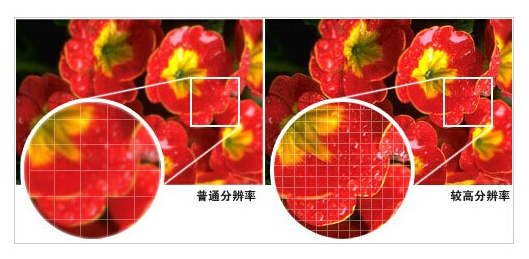Shenzhen Dehong Vision Technology Co., Ltd.
Phone: 137 2892 0823
Fax: 0755-2372-6873
Email: 908450505@qq.com
Website: www.dhkj123.com
en.dhkj123.com
Address: Goldman Sachs Building, No. 18 Shajing
Center Road, Baoan District, Shenzhen
Resolution is the precision of the screen image and refers to how many pixels the display can display. Since the points, lines, and faces on the screen are made up of pixels, the more pixels the display can display, the finer the picture. Similarly, in the concept of industrial cameras, the size of the resolution is also represented by the number of pixels. In the same field of view, higher resolution means more information displayed, higher recognition accuracy, and better visibility of image details, so resolution is one of the most important performance indicators.
So, the higher the resolution of the camera, the better the image effect? Let us first look at the picture below.

From the pictures, we can see that in the same display area, the pictures taken by the camera with higher resolution are indeed much better in terms of overall clarity and picture details. Therefore, from this perspective, without considering the influence of other factors, the size of the resolution is proportional to the quality of the image.
So what other factors will be included?
In fact, the pixel and image sensor (CCD or CMOS) photosensitive unit is not a simple one-to-one correspondence. Image sensors with the same number of pixels have different area sizes. The larger the area, the larger the size of a single pixel, the more light intensity information it can receive, the higher the probability of high-light overflow, and the lower the chance of noise, the closer the normally generated photos will be. , The image quality will be better. On the contrary, the smaller the size of the image sensor, the smaller the size of each pixel, the fewer light signals it can sense, the fewer the number of photoelectrons, and the larger the fluctuations, the signal needs to be amplified during the photoelectric signal conversion process. Zoom in, it is easy to produce image noise, which affects image quality. In addition, the small size of the sensor and the large number of pixels will cause the pitch between pixels to be too close, which will also increase the image noise.
From this point of view, it is not advisable to blindly pursue high pixels and ignore the size of the image sensor, and the benefits may outweigh the disadvantages.
In summary:
1.High pixels do not necessarily bring high picture quality, and too high pixels have a negative effect on the improvement of image resolution, sensitivity, and noise control ability;
2.The size of the camera's photosensitive element basically determines the grade of the camera, such as the high-end DC CCD must be larger than the low-end area;
3, whether CMOS or CCD, the larger the area of a single pixel, the larger the heat dissipation space, the stronger the ability to control noise, and the less the pixel is affected by the diffraction spot, the better the imaging effect;
4. Whether high pixels can bring high image quality depends on whether the area of a single pixel is still sufficiently high-resolution at the commonly used minimum aperture value. Under the condition of ensuring imaging clarity, the higher the pixel, the better the photo The richer the details, the more vivid the layers, and the higher the picture quality.

attention
Shenzhen Dehong Vision Technology Co., Ltd.
Phone: 137 2892 0823
Fax: 0755-2372-6873
Email: 908450505@qq.com
Website: en.dhkj123.com
Address: 19th Floor, Goldman Sachs Building,
No. 18 Shajing Center Road, Baoan District, Shenzhen
